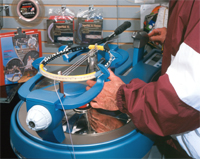|
|

What You Don't Know About Tension Can Cause Headaches with Your String
By Steve Crandall
Vice President, Sales & Marketing
Ashaway Racket Strings

Electronic machines continuously pull the string, resulting in about 10% more tension than stringing with manual machines. Rackets strung with electronic machines also tend to hold tension better. |
We've talked a lot in this column about stringing tight for control and stringing loose for power, but we haven't talked about the subject of string tension itself. And if, like me, you tend to hang around the stringing booth at tournaments, you'll know there's actually quite a bit to learn. Understanding tension may not help improve your game, but it can definitely help you avoid stringing headaches.
But to do the topic justice, I wanted to tap into a real expert on the subject. Vince Chiarelli is one of the most experienced stringers I know and someone I've worked with at many tournaments. A Master Racquet Technician and owner of String Along with Vince in Largo, FL, Vince has strung over 20,000 rackets across all racket sports over the years, and has even strung for top pros at Championships like the French Open, the China Open in Beijing, the NASDAQ-100 in Florida, and many more. Here's a brief synopsis of what Vince had to say about tension:
Whenever we string at tournaments, we always ask players what string they use, what tension they normally string to, and what type of machine they normally have their rackets strung on. This is because string tension depends not only on the type and gauge of the string, but also on the type of machine used to do the stringing and how well that machine is calibrated.
There are a number of things players need to understand about tension. The first, of course, is that different string materials respond to tension in different ways. Some materials are more elastic and will act differently than others even when strung to the same tension. The way strings are constructed is also a factor. For instance, a solid monofilament string will be stiffer when the ball hits the string bed than a string that has a smaller, monofilament core and one, two or three wraps of smaller filaments around that. There will be more elasticity to the monofilament core type, since it is a thinner core. On the other hand, a multifilament string, which could have over a thousand separate filaments, will stretch more when the ball is hit. That means you're going to get more power out of it for the same tension, especially with multifilament nylon and Zyex(r) fibers, like Ashaway's SuperNick(r) XL and PowerNick(r). And you're going to get more comfort, because it will absorb some of the shock of the ball coming in.
But getting 'the same tension' is not as easy as it sounds. What many people don't realize is that different types - and makes - of machines will tension strings differently.
The biggest difference is between manual, or 'lock-out tension' machines, and 'continuous pull' electronic machines like those made by Babolat. Generally, you'll get about 10% higher tension with an electronic machine, even when they're both set to the same weight. This is because the manual machines use a hand crank to pull the string. When they get to the desired tension, they 'lock' and stop pulling. As soon as that happens, the string begins to relax, so that by the time you've gotten the string clamped, it has already lost some tension.
Electronic machines keep pulling at the desired tension, until you clamp the string. We did a number of direct comparisons when I was stringing with Ashaway at a tournament a few years ago and found that if both a manual and electronic machine were set to 32 lbs, the string on the manually strung racket would test out at only 28 - 29 lbs.
The other thing is that rackets strung with electronic machines hold tension better, so the tension loss over time is not so great. I'm not sure I understand exactly why or how this happens, but we've confirmed it: an electronic stringing job will hold tension better.
That said, there is a manual machine, called a drop-weight machine, which does continually pull the string. It uses an arm with a heavy cylinder on it to pull the string. The arm is calibrated and you move the weight to the desired tension. However, these machines are tricky to use. In order to achieve the proper tension, the arm has to rest parallel to the work surface once the string is attached. If you don't get it perfect the first time, you have to stretch the string again which can result in uneven tension across the bed.
Another thing people don't realize - including some stringers - is that stringing machines need to be calibrated in order to perform to specification. When we string tournaments, we calibrate our machines every day, but that's not always the case. My advice to players attending tournaments is to always have one racket strung first as a test. Practice with it to see how it feels, then have the stringers adjust from there.
This article previously appeared in Squash Magazine.
|